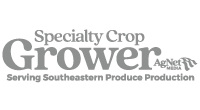Citrus Research and Development Foundation (CRDF) Chief Operations Officer Harold Browning reports on the conclusion of the five-year NuPsyllid project aimed at developing a psyllid that won’t spread HLB. “The NuPsyllid project was a project funded through the USDA competitive grant program and was established in 2012 to develop a psyllid that would not be capable of transmitting the (HLB-causing) …
Current Challenges to Florida Citrus
Editor’s Note: This article was written before Hurricane Irma made landfall in Florida and damaged the state’s citrus industry. This article is part of the special 100th anniversary coverage of the Citrus Research and Education Center, found in the October 2017 issue of Citrus Industry magazine. By Tom Nordlie What are the current challenges to Florida’s citrus industry? To a …
Gmitter on Surviving HLB, What to Plant and Lemon Potential
In a wide-ranging talk at Citrus Expo in August, University of Florida Institute of Food and Agricultural Sciences researcher Fred Gmitter discussed many topics important to growers. Subjects included making variety decisions when planting, surviving HLB, and the potential for lemons in Florida. He summarizes his discussion: “We can give information (about citrus varieties), but we don’t want to give …
Keep Spraying Psyllids in HLB-Infected Groves
In a Citrus Expo talk, University of Florida Institute of Food and Agricultural Sciences entomologist Phil Stansly focused on the importance of continuing to spray psyllids in groves already infected with HLB. The main reason to do that, he says, is to keep psyllids from re-inoculating trees with HLB by “pumping more and more bacteria into that tree.” He …
Organic Management for HLB
By Jaci Schreckengost One of the topics researchers and growers discussed at the 2017 Organic Food & Farming Summit was what can be done organically to combat huanglongbing (HLB), also known as citrus greening disease. Florida Organic Growers hosted the summit in Gainesville. It featured many workshops in which researchers and growers could discuss challenges and management practices. Tripti Vashisth, …
Hurricane Recovery Hotline for Citrus Growers
As growers assess the damage from Hurricane Irma, University of Florida/Institute of Food and Agricultural Sciences (UF/IFAS) citrus specialists are available to answer their questions related to hurricane recovery practices for HLB-affected citrus groves. To provide answers as quickly as possible, the UF/IFAS Citrus Growers’ Hotline (863-956-8611) has been established for growers to call with their questions. Staff will be answering the …
Growers Report on Use of Bactericides for HLB
Ariel Singerman, economist with the University of Florida’s Institute of Food and Agricultural Sciences, reports on a grower survey he conducted regarding use of bactericides against HLB. “According to my survey, which included 62 growers accounting for approximately 160,000 acres, 92 percent of the growers applied bactericides,” Singerman says. “The majority did three applications, and they spent between $100 and …
Grower Jerkins Revises Stance on Bactericides
At Citrus Expo in August, Premier Citrus President Tom Jerkins clarified comments about bactericides and their effectiveness that he made at the June Florida Citrus Mutual conference in Bonita Springs. “In Bonita Springs, I kind of stated publicly it was difficult for Premier to see a difference in the treated (with bactericides) versus untreated,” Jerkins says. “I said it was …
More Fruit, Better Tree Health in Highlands County
Echoing comments from growers in some citrus-growing regions in southern Florida, Highlands County citrus Extension agent Laurie Hurner says Highlands County appears to have more fruit and better tree health this year. “It’s interesting. You drive up and down Highway 27, and there is a lot more fruit out there, I think,” says Hurner, who is also the Highlands County …
Bactericides, Psyllids and HLB-Resistance/Tolerance
At a recent meeting of the Citrus Research and Development Foundation’s (CRDF) Commercial Product Delivery Committee, approximately half of the agenda was devoted to bactericides and HLB-spreading psyllids. Reflective mulch that keeps psyllids away and field trials for HLB-resistant or tolerant rootstocks and scions were also addressed. CRDF Chief Operations Officer Harold Browning summarizes some of the discussions. “The issue …
System Screens Out Citrus Greening-Carrying Insect
Imagine camping in the deep woods. You’d want a tent with mesh that prevents bugs – even those as small as gnats – from entering into your wildlife hangout. That’s the idea behind citrus under protective screens, or CUPS, which helps keep away a pinhead-sized insect that causes citrus greening, University of Florida/Institute of Food and Agricultural Sciences (UF/IFAS) scientists …
HLB-Spreading Psyllids Resistant to Insecticides
Ears perked up in the Citrus Expo seminar hall last week when Lukasz Stelinski reported incidences of Asian citrus pysllid resistance to insecticides, “particularly the neonicotinoid group of insecticides in Florida.” The neonicotinoids have been a key weapon against the psyllids that have spread HLB to groves statewide. Stelinski, an entomologist with the University of Florida’s Institute of Food and …
CRDF President on Bayer Partnership
We first told you last week that the Citrus Research and Development Foundation (CRDF) and Bayer CropScience had announced a new partnership during Citrus Expo to fight citrus greening. Various solutions are being researched, like genetically improved trees. But CRDF President Tom Jerkins knows help is needed before those trees are ready. Sponsored ContentTake Advantage of Rising Temperatures to Treat …
Rootstocks and HLB Tolerance — Another Perspective
By Ute Albrecht Tolerance to a disease is generally defined as the ability to be productive in the presence of disease-causing organisms. This is contrary to resistance, which is defined as the ability to completely evade a pathogen due to specific resistance mechanisms. The question as to what defines an HLB-“tolerant” rootstock was posed in an article by Bill Castle, …
Ag Secretary Perdue Gains Optimism About Citrus Industry at Citrus Expo
U.S. Secretary of Agriculture Sonny Perdue visited Citrus Expo on August 16. During his visit, he held a listening session alongside Congressman Tom Rooney and citrus industry professionals. The main topic during the session was citrus greening and the importance of research to combat the devastating disease. Growers and industry leaders spoke about the challenges of the Florida citrus industry. …
Perdue Optimistic Researchers, Growers Will Beat Citrus Greening
U.S. Agriculture Secretary Sonny Perdue is in Florida this week, where he attended Citrus Expo at the Lee Civic Center in North Fort Myers. While in the state, he has been able to learn firsthand about efforts to combat citrus greening. Hear more from the U.S. Department of Agriculture’s Stephanie Ho: Sponsored ContentTake Advantage of Rising Temperatures to Treat for …
CRDF and Bayer Announce Partnership at Citrus Expo
The Citrus Research and Development Foundation (CRDF) and Bayer CropScience announced a new partnership at Citrus Expo. In an effort to discover new technologies to manage citrus greening disease, CRDF will invest $12 million with Bayer over a three-year period. Bayer will focus on product research and development of both biological and chemical controls. Adrian Percy, head of research and …
How the Best Growers Cope with HLB
Some of Florida’s “best” citrus growers recently told Citrus Research and Development Foundation (CRDF) researcher Jim Syvertsen how they try to cope with HLB. There was much agreement among the growers on fertilization, irrigation, the management of psyllids that spread HLB, and bactericides that have been used against HLB for more than a year. Syvertsen says a survey conducted …
HLB Affects Grapefruit Sales
By Jaci Schreckengost For grapefruit growers, huanglongbing (HLB) has been a huge issue, leading to many fears in the industry, including the fear of a shortage. Rob Atchley, general manager of citrus groves for Duda Farm Fresh Foods, says HLB makes crops vulnerable to new stresses the trees have not previously encountered. He says these stresses can turn into fruit …
UF Researchers Work to Manage HLB in Grapefruit
By Jaci Schreckengost Due to the rapid rate huanglongbing (HLB) has affected citrus, researchers are working on new management techniques for the disease. Rhuanito “Johnny” Ferrarezi, assistant professor in citrus horticulture at the University of Florida/Institute of Food and Agricultural Sciences (UF/IFAS) Indian River Research and Education Center (IRREC), says research is being done to answer questions about how HLB …





























